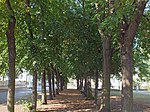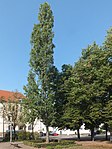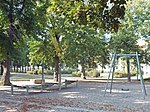Richterplatz (Leipzig)
| Judge's place | |
|---|---|
| Place in Leipzig | |
 Judge's place with greyhound imitation (2020) |
|
| Basic data | |
| place | Leipzig |
| District | Center-North |
| Created | 1910 |
| Newly designed | 1996 |
| Confluent streets | Ehrenstein, Fricke, Trufanow and Richterstrasse |
| use | |
| User groups | Pedestrians, children playing |
| Technical specifications | |
| Square area | approx. 0.7 ha |
The Richterplatz is a jewelery and playground in the Leipzig district of Zentrum-Nord. Like the street of the same name, it is named after the councilor and council builder Johann Caspar Richter (1708–1770), the builder and owner of the Gohlis castle . The Richterplatz is a listed building .
Location and layout
The Richterplatz is a rectangle 110 m long and 70 m wide, which extends from southwest to northeast between Richterstrasse and Frickestrasse. The lateral boundaries are Trufanowstrasse and Ehrensteinstrasse. With Ehrensteinstrasse, the site is right on the border with the Gohlis- Süd district.
The square is strictly geometrically structured in terms of the network of paths, lawns and trees. The south-western half contains three lawns and six box-tree-lined squares, each with a pyramid poplar. This part of Ehrensteinstrasse and Trufanowstrasse is lined by double rows of linden trees. Elms , pyramid poplars and shrubbery stand on Richterstrasse . Park benches invite you to linger.
The children's playground on the north-eastern half is almost completely shaded by linden trees and separated from the streets by bushes. There are also table tennis tables, sand play areas, a swing and a seesaw board. The eye-catcher in the north-eastern access axis is a spiral wind chime .
history
The area of the parade ground for the Saxon troops stationed in Leipzig- Gohlis was parceled out and built on at the beginning of the 20th century . Three representative buildings were built around a square of streets: in the northeast the Schiller-Real-Gymnasium, opposite in the southwest the Intendant's office and in the southeast the command office of the military association.
The space in between was set up as a decorative space, the plans of which were designed by the Leipzig gardening director Carl Hampel (1849–1930). In 1916 the life-size bronze group “Pro patria” by the Leipzig sculptor Mathieu Molitor (1873–1929) was set up on the edge of the square opposite the Schiller-Gymnasium , which was melted down in 1941 for war purposes.
In the Second World War , the Schiller-Real-Gymnasium was destroyed and in the post-war period this area was built on with row houses without reference to the square. The judge's place was maintained with little effort and lost its representative appearance. In 1996 the old structures were restored during a thorough renovation. The Saxon Finance Court now resides in the former headquarters and the directorate is used by the Medical Vocational School of the Leipzig University Hospital .
literature
- Petra Mewes, Peter Benecken: Leipzig's Green - A Park and Garden Guide . Passage-Verlag, Leipzig 2013, ISBN 978-3-938543-49-8 , pp. 52/53 .
Web links
- Playground Richterplatz. In: Website of the city of Leipzig. Retrieved August 15, 2020 .
Individual evidence
- ↑ List entry. In: Cultural monuments in the Free State of Saxony. Retrieved August 15, 2020 .
- ↑ Petra Mewes, Peter Benecken: Leipzig's Green - A Park and Garden Guide . Passage-Verlag, Leipzig 2013, ISBN 978-3-938543-49-8 , pp. 53 .
Coordinates: 51 ° 21 ′ 25 ″ N , 12 ° 22 ′ 24 ″ E





